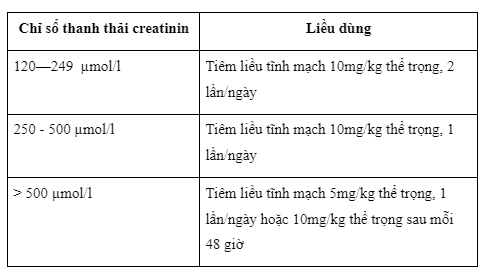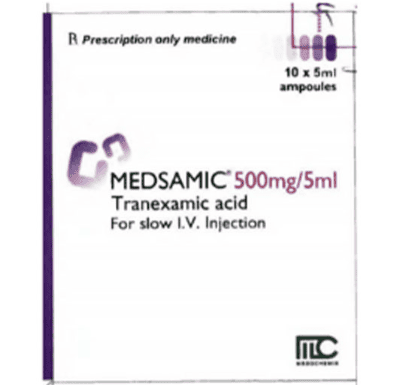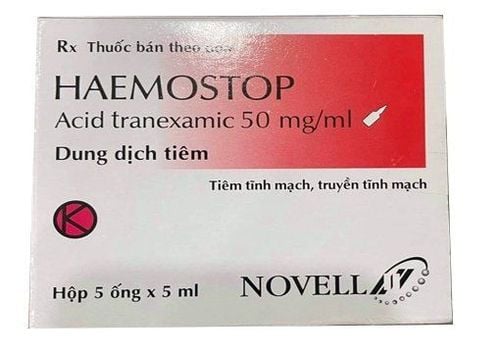This is an automatically translated article.
Ajecxamic with the main ingredient is tranexamic acid, indicated for the treatment of abnormal bleeding cases during and after surgery, obstetrics and gynecology, urology, nosebleeds, renal bleeding, polymenorrhea,... Here is some information to help you understand what Ajecxamic does? How to use?
1. What effects does Ajecxamic have?
Ajecxamic is prepared as a solution for injection, each 5ml tube contains tranexamic acid 250mg. Ajecxamic is used in the treatment of abnormal bleeding during and after surgery, obstetrics and gynecology, urology; hemorrhagic disease; polymenorrhea; hemolysis due to pulmonary tuberculosis, bleeding from the kidneys and nose.2. Dosage and how to take Ajecxamic
Ajecxamic slow intravenous injection or intravenous infusion after dilution. Inject 0.1ml/min with undiluted Ajecxamic solution. Dilute 1%, then IV infusion 5ml/min. Dilution 2%, then intravenous infusion 2.5ml/min. For adults undergoing cardiac surgery, the recommended rate for prolonged intravenous infusion is 4.5 mg/kg/hour.
Dosage of Ajecxamic varies depending on age and type of disease:
Systemic fibrinolysis: Slow intravenous injection of 0.5-1g of tranexamic acid, equivalent to 10-20ml of Ajecxamic or 10mg/kg with a frequency of 3 times /day. Or intravenous infusion at a dose of 25-50mg/kg body weight per day. For children, intravenous dose of 10mg/kg, usually used 2-3 days depending on the effectiveness of treatment. Prostatectomy: Intravenous dose 10-20ml, 2-3 times / day, the first dose is used during surgery, the next doses are used in the first 3 days after surgery. Then take 2-3 tablets (1g/tablet), frequency 3-4 times/day until no gross hematuria. Dental surgery for people at risk of bleeding: Use immediately before surgery with an intravenous dose of 10mg/kg body weight. After surgery at a dose of 25 mg/kg body weight, coagulation factors may still be required. Cardiovascular surgery: For adults, after anesthesia and before skin incision, use preoperative dose of 15mg/kg, during surgery continue intravenous infusion dose of 4.5mg/kg/hour, of which 0.6mg/hr. kg of this injection may add to the cardiopulmonary priming volume. For children over 2 years of age, the preoperative dose is 10mg/kg as a bolus, while surgery can be given as an intravenous infusion or a bolus dose of 10mg/kg. For patients with renal impairment, the dose should be adjusted based on the creatinine clearance index:

No dose adjustment is required for patients with hepatic impairment. Children intravenously 20mg/kg/day depending on indications for treatment. However, data on dosage, safety and effectiveness are still very limited. Elderly patients do not require dose reduction unless there is evidence of renal impairment.
3. Contraindications to the use of Ajecxamic
Ajecxamic is contraindicated in the following cases:
Hypersensitivity to tranexamic acid. People with a history of blood clots. Central nervous system surgery, central nervous system bleeding, subarachnoid hemorrhage and other cases of brain bleeding. Severe renal failure, history of convulsions.
4. Side effects of the drug Ajecxamic
During the use of Ajecxamic, the drug may cause some of the following side effects:
Common: Gastrointestinal disturbances (nausea, vomiting, diarrhea), dizziness. Uncommon: Post-injection hypotension. Rare: Change in color perception, ischemia, cerebral infarction (when used to treat subarachnoid hemorrhage), headache, hydrocephalus, dizziness, convulsions (especially in cases of abuse) drug use). Dosage should be reduced if gastrointestinal disturbances occur and discontinuation of the drug in the presence of visual disturbances.
5. Drug interactions
Possible interactions when using Ajecxamic with the following drugs:
Do not take tranexamic acid with estrogen at the same time because it may increase the risk of thrombosis. Use with caution with other hemostatic agents. Use with caution with Tretinoin. Absolutely do not mix Ajecxamic injection solution with solution containing Penicillin or blood for transfusion. Can only be mixed with 0.9% sodium chloride, 5% glucose, Riger lactate solution. Can be mixed with Heparin into the same solution for infusion. The article has provided information about the effects of Ajecxamic, dosage and notes when using. To ensure safety for your health and maximize the effectiveness of treatment, you need to take Ajecxamic medicine exactly as directed by your doctor.
Please dial HOTLINE for more information or register for an appointment HERE. Download MyVinmec app to make appointments faster and to manage your bookings easily.













